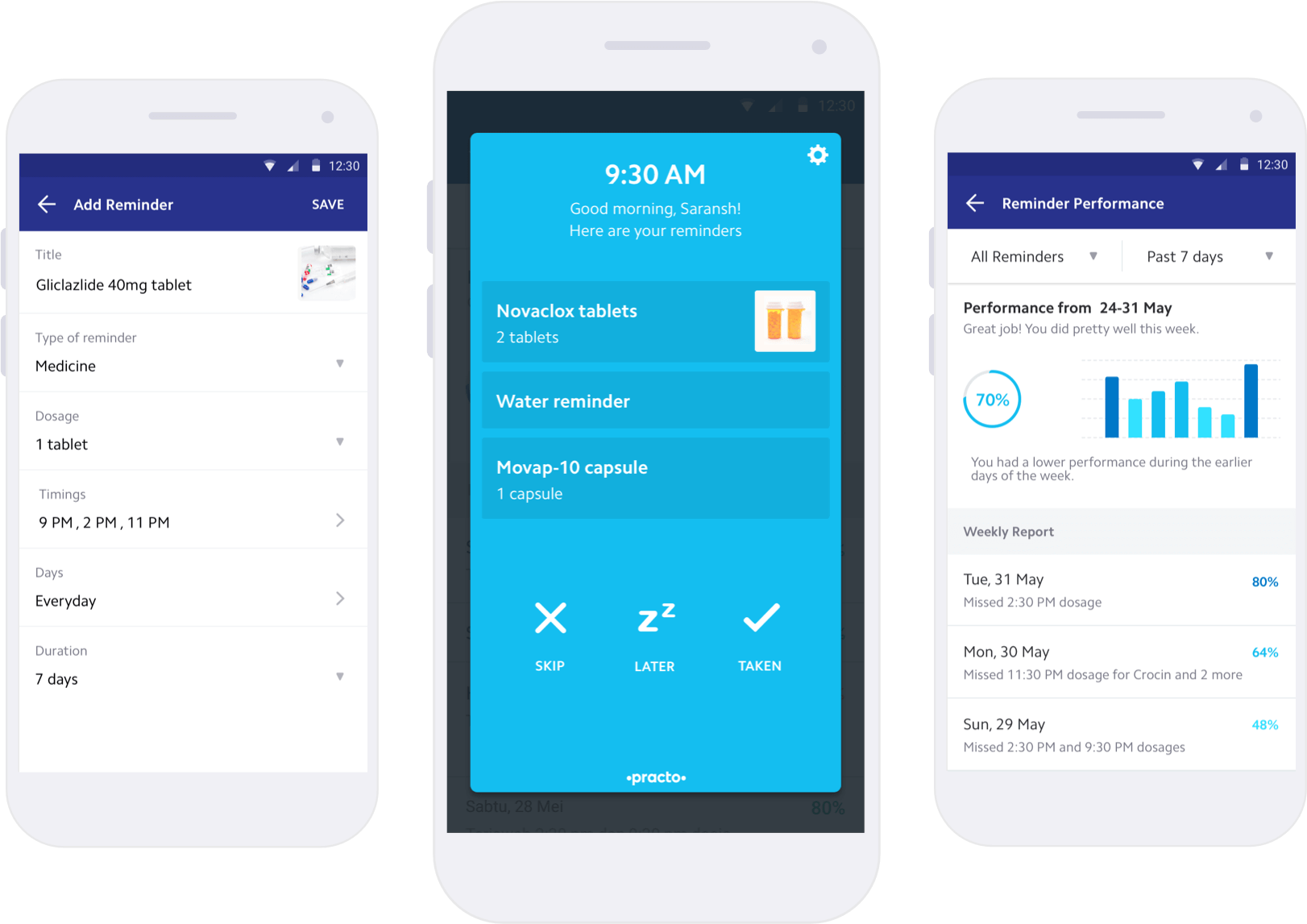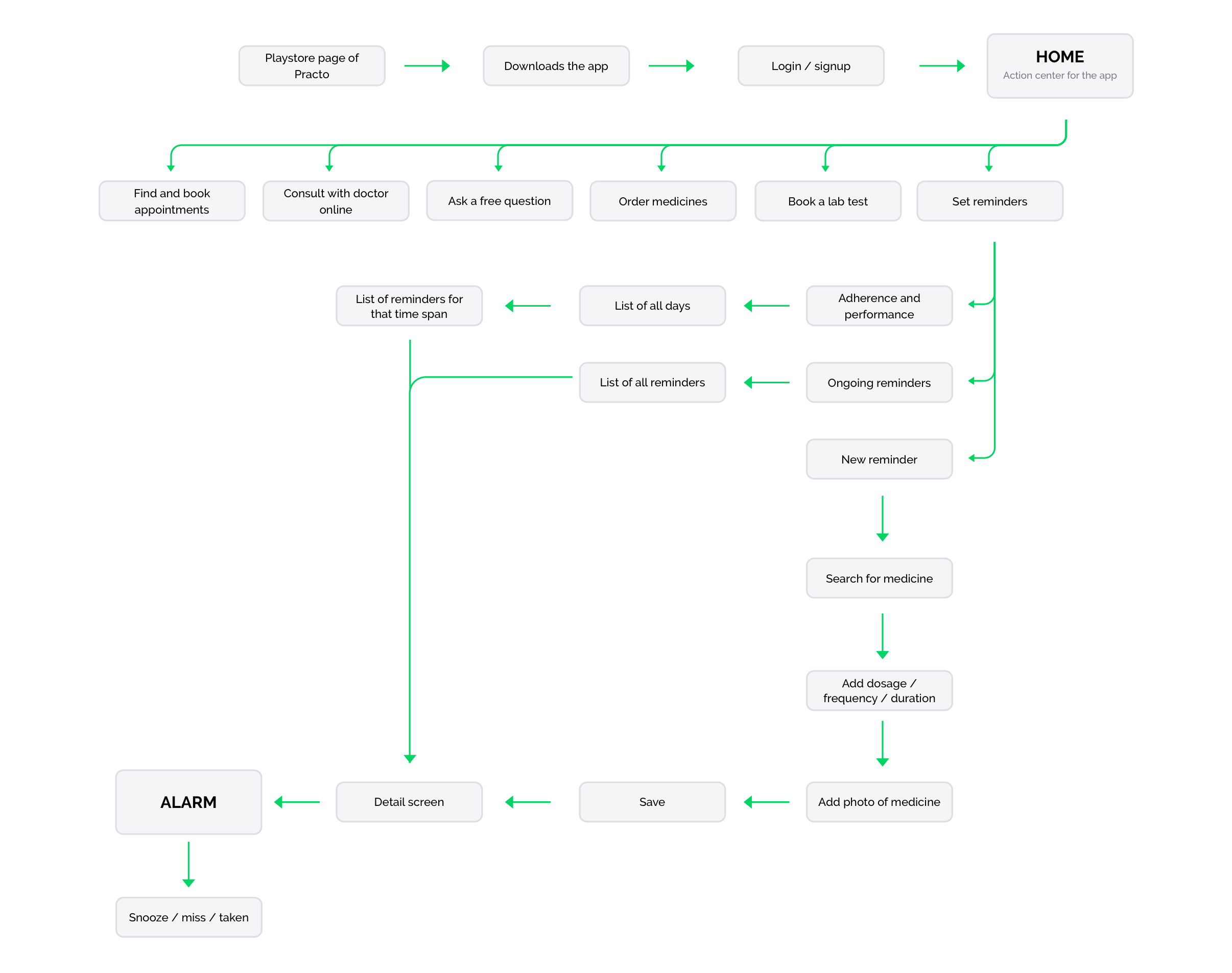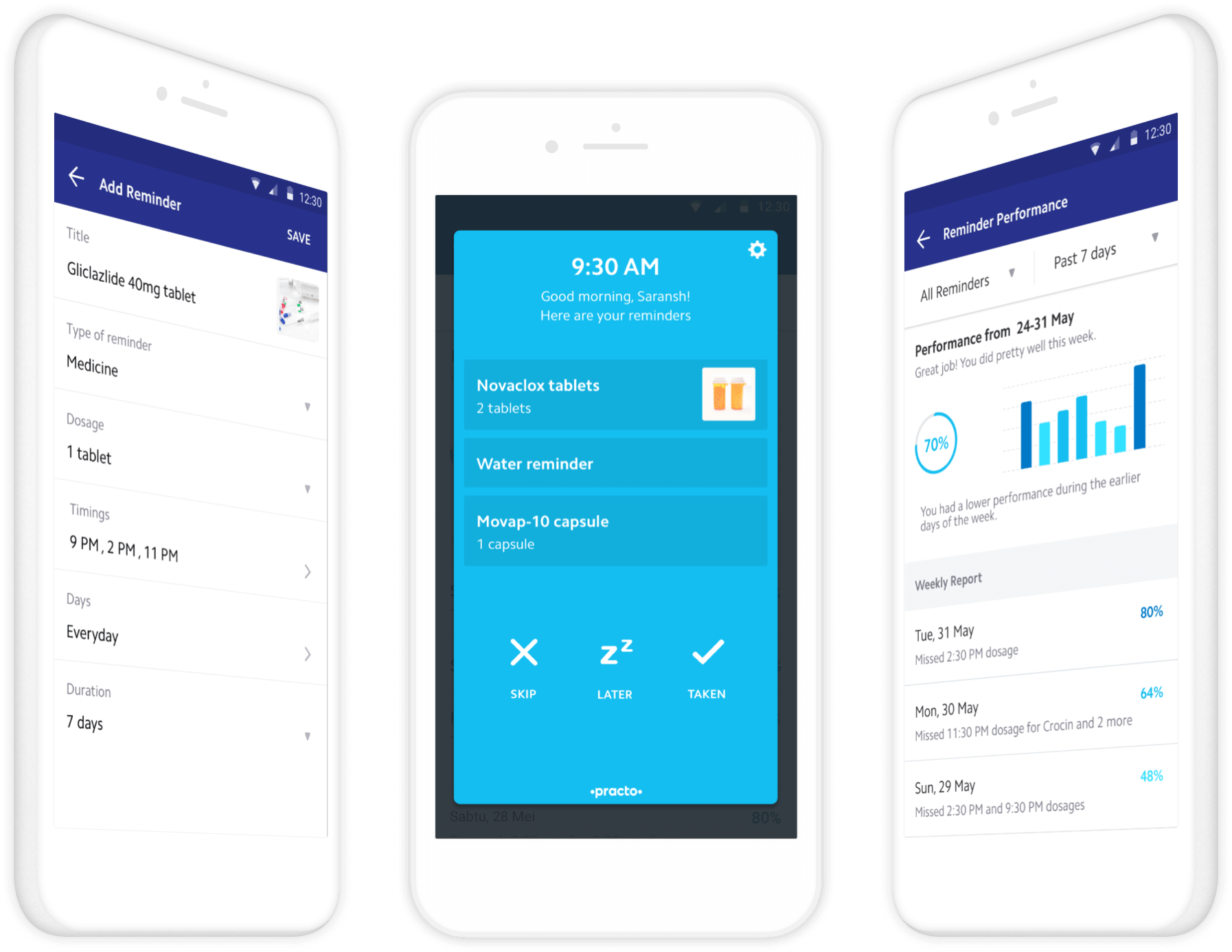Medicine Reminders for Chronic Patients
Product design / Research / Martet Analysis / Healthcare
A product aimed to solve all cases of unintentional medication non-adherence which are caused by simple forgetfulness
Practo, Bangalore

Reminders at Practo
Reminders, as a feature, was launched in early 2016 onto the Practo app. The launch was just after the addition of the Health records product which provided us with significant amount patient data and helped us understand their need to manage and consumer medications better.
Team & role
- Timeline and duration: July 2015 - July 2017 (2 years)
- I led the design of Reminders for the Practo app since the outset of the project in July 2015.
- Deliverables: Market analysis, secondary research, contextual inquiry, interaction design, motion design.
- I partnered with three product managers to build this functionality that matched customer behaviors and motivations. Reminders has turned out to the most engaging product on the app.
Setting up the context
Taking prescription medication is a routine part of everyday life for nearly 52% of all Indians. Even with the risk of facing dangerous consequences for failing to consume these, sometimes very essential, medications, patients can still forget to take them due to simple forgetfulness and unintended neglect.
With this initial information about the space, I dug deeper to understand the problem better.
At the same time, we tried to avoid one major mistake we had done earlier. Letting the question "how fast can we ship it?" define the "it," rather than our users.
Users & Audience
Our initial data-analysis showed that the users coming to Practo app were chronic patients, migrant patients, or caretakers. But all of them had voiced their need for a reminder tool through customer tickets and feedbacks.
Hence, the Leadership team along with the Strategists decided to build a reminder tool with a simple assumption. Millions of customers visit Practo every month. Extend the feature to all these users by leveraging the existing infrastructure to get to market sooner and cheaper.
You can read more about the targeted user groups on the Practo app here.
Contextual inquiry and surveys
I conducted semi-structured user interviews and studied the ways our users were buying and taking medicines. I observed and questioned patients or caregivers while they tried to go around doing their medical tasks.
These made me understand their habits, frustrations and critical pain-points. We also sent out surveys to our users to gather more quantitative information. These were the key insights which were unveiled :
- Almost all users perform specific tasks to help them remind take medicines. These include placing their medicine in locations that will have a higher chance of attracting their attention.
- A significant fraction of our users needs someone (usually the family caretaker) to remind them to take medicines. Some even forget the dosages to take as they have misplaced their prescription.
- Around 20% users were using their smartphones to set alarms. However, these were hard to use and very rigid in structure.
- A few users (usually chronic) used physical products to remind them to take medicines.
- Other chronic patients have made habitual changes which took them 4-5 months.
- Many users mentioned that they often forget to take medicine when they are out of home.
- None of the users remember the name of the medicine after a week. They tend to identify the medicine by its color, shape or packaging.
Market analysis
p> I asked our users during the interviews on the tools they currently use. These were digital as well as physical products. I spent time to understand the fundamental offerings, positioning, and differentiators of each of these products.

Some of the physical tools present in the market which work as medicine reminders
Epill and Epillmedtimer are some of the physical reminders present in the market. These have a medicine case in which all the pills are stored. Some key-points users mentioned:
- They do not tell about the dosage of medicines to be taken
- On the other hand, these are helpful triggers to know when the medicines are going to end
- Designed mainly for Alzheimer patients
- Extremely costly. Some of them cost as high as $250 (INR 16,000)
- Setting up a reminder is not easy at all. Also, not a lot of adjustments in timings and other variations can be done.
- It isn't an intelligent tool and works just as a simple alarm tool
Next, I evaluated the current mobile app solutions existing on the app stores (Android and iOS). According to a paper written in 2014 by Stawarz, Cox, and Blandford in 2014, there are as many as 229 mobile applications which can be considered in some way to be a medicine reminder tool.

The functionality offered by smartphone reminder apps. Source: usabilitypanda
As we can see from this graph, apps provide a varying amount of functionality. However, all of them need the user to set up the reminder by going through a long, tedious process. In many cases, these reminders are very similar to SMS reminders or the phone alarm clocks and they do not have must-have actions such as snooze present.
Other issues found during the contextual inquiries:
“I have a medicine I take every 4 days, no app allows me to set this up easily!"
"Does nothing more than my phone's alarm. No snooze functionality if I am not around my medicine at the moment."
- Very long and confusing form to fill to add a reminder.
- Not usable for irregular pill dosages. Inflexible and not robust.
- No adherence tracking.
- Hygiene alarm functionalities such as snooze, smart silencing and smart alerts not been used.
- Patients mostly remember pills by their shape and color and not their name. None of the tools have an option to identify meds by their shape and color.
- Almost all applications do not use the full potential of the platform.
Design Response
Using the Practo ecosystem
Practo has built an entire ecosystem of products for doctors and other healthcare providers. Doctors can quickly, and seamlessly create and share prescriptions with patients. Practo, using the data and medicine information present in the prescriptions shared by doctors, sets up reminders for the patients automatically on their health app.

Doctors share prescription which creates a reminder automatically
Self-addition of reminders
For patients who do not go to doctors who use any of the Practo software, we created a straightforward tool to add reminders. Smart defaults, clean interface, and a flexible structure made the feature very easy to use.
We went through many iterations, tested them with users, got a lot of feedback before finally rolling out the final product on to the Practo app.
The objective was to design an interface which would require little to no technical knowledge and hence could be used by any user on the Practo ecosystem who needs to take medicines.

User flow for adding a reminder to the app

Some of the iterations made for the reminder addition flow
Notifications and alerts
We took advantage of mobile platform's own notification system and created an end-to-end notification framework for users to be reminded on when to take their medicines. We also created an adherence tracking system for users to mark when they missed a dosage.

Notification and widgets created to increase the usability of reminders
Current version
We launched the first version of reminders in January 2016. The product took a lot of iterations and redesigns to reach a minimum desirable experience for our users. We tried to avoid one major mistake we had done earlier. Letting the question "how fast can we ship it?" define the "it," rather than our users.
We know the pain-points faced by our users in the current solution provided to them and worked tirelessly to fix them.

Outcome
Reminder is a tool which was aimed to help patients solve all cases of unintentional medication non-adherence which are caused by simple forgetfulness. The product has seen some fantastic results since its launch. However, it is still day one here.
- Extremely high user engagement.
- 200,000+ reminders set till date.
- Customer satisfaction (CSAT) above 4.5